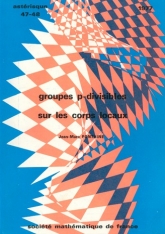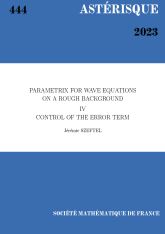Groupes $p$-divisibles sur les corps locaux
Groupes $p$-divisibles sur les corps locaux

- Consulter un extrait
- Année : 1977
- Tome : 47-48
- Format : Électronique, Papier
- Langue de l'ouvrage :
Français - Nb. de pages : 264
- ISBN : ISBN-13 978-2-85629-467-3
Let $k$ be a perfect field of characteristic $p\neq0$, let $A = W(k)$ the ring of Witt vectors with coefficients in $k$ and let $D_{k} = A[\underline{F},\underline{V}]$ the Dieudonne-ring, i.e. the (non-commutative, if $k\neq \mathbb{F}_{p}$) ring generated by $A$ and two elements $\underline{F}$ and $\underline{V}$ subject to the relations
$$
\left\{
\begin{array}{ll}
\underline{F}\underline{V} & = \underline{V}\underline{F} = p\, , \\
\underline{F}a & = \sigma(a) \underline{F},\, a\underline{V} = \underline{V}\sigma(a), \,\textrm{for any}\, a \in A
\end{array}
\right.
$$
(where $\sigma$ is the absolute Frobenius on $A$ ).
It is well-known that commutative finite group-schemes, of rank a power of $p$ , can be classified by their Dieudonne-modules, which are left $D_k$-modules , of finite length as $A$-modules.
By using Witt covectors, we give a new description of the Dieudonne-module $\underline{M}(G)$ of such a group $G$ : we construct a commutative formal group-scheme $C\widehat{W}_{k}$ over $k$, whose endomorphisms ring contains $D_k$ , and then $\underline{M}(G)$ is defined as $Hom(G,C\widehat{W}_{k})$ . This construction avoid the decomposition of the group into an unipotent group and a multiplicative type one. We give also a description of $G$ , as a group-functor, in terms of $\underline{M}(G)$ : if $M = \underline{M}(G)$, for any finite, commutative and associative $k$-algebra $R$, the group $G(R)$ can be identified, canonically and functorially in $R$ and $G$ , to ${Hom}_{D_{k}} (M, C\widehat{W}_{k}(R))$.
Since Grothendieck and Messing, one knows that it is possible to associate to any $p$-divisible group $H$ over $A$ a couple $(L,M)$ , where $M$ is the Dieudonne-module of the special fiber of $H$ and $L$ a suitable sub-$A$-module of $M$, and that the correspondence $H \to (L,M)$ classifies $p$-divisible groups over $A$. A new construction of the functor $H \to (L,M)$ is given (actually, not exactly the same $(L,M)$ as in Grothendieck or Messing). We give also a description of a quasi-inverse functor, as well as a description of the Tate-module of $H$ in terms of the couple $(L,M)$.


